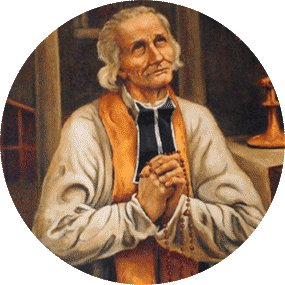
4 August
St. John Baptist Mary Vianney (1786-1859)
Cure of Ars, Patron Saint of Parish Priests
Born: May 8, 1786, Dardilly, France
Died: August 4, 1859, Ars-sur-Formans, France
Canonized: 1925, Rome by Pope Pius XI
Major Shrine: Shrine of St. John Vianney; Ars-sur-Formans, France
Patron of: parish priests; confessors
St. John Baptist Mary Vianney (1786-1859) was born in Dardilly and died in Ars, France. Although his talents were limited and his education meager, he was ordained a priest in 1815. After three years at Ecully, he was appointed parish priest of Ars. Here he spent almost forty-two years of his life, devoting himself to prayer, mortification, and pastoral works. His success in directing souls made him known throughout the Christian world. Men of all ranks and conditions of life sought his guidance and advice. He was beatified by Pope St. Pius X, himself once a parish priest, and canonized by Pope Pius XI.
COLLECT PRAYER
Almighty and merciful God, who made the Priest Saint John Vianney wonderful in his pastoral zeal, grant, we pray, that through his intercession and example we may in charity win brothers and sisters for Christ and attain with them eternal glory. Through our Lord Jesus Christ, your Son, who lives and reigns with you in the unity of the Holy Spirit, God, for ever and ever.
Things to Do:
- The Collect praises St. John Vianney’s zeal for souls and his spirit of prayer and penance. Say a special prayer today that by his example and intercession we too may win the souls of our brothers for Christ.
- Say a prayer for priests that they may persevere in their vocation. If you haven’t been to confession for a while resolve to do so right away and be sure that you remember to say an extra prayer for your confessor.
- From the Catholic Culture library: Pope John XXIII holds St. John Vianney as a model for the priesthood in this Encyclical.
- Read this longer life of the Curé of Ars and also these excerpts from his sermons.
During the French Revolution a small band of Ursuline nuns was imprisoned in the Bastille. To cheer her disconsolate companions, one of the group passed wheaten discs of bread, cut from the loaf of the daily rations, to memorialize the happy days when they were free and could receive Our Lord in Holy Communion. At that time all religious schools and churches were closed, and those who harbored priests were imprisoned.
At the Vianney farmhouse near Dardilly, France, fugitive priests were offered a refuge. Here their son was prepared in his tenth year for the reception of Holy Communion by a hunted priest.
While tending his father’s sheep, John Vianney fashioned a small statue of Our Lady out of clay. He hid it in the hollow of an old tree with this petition:
“Dear Lady Mary, I love you very much; you must bring Jesus back to His tabernacles very soon!”
On a visit to his aunt at Ecully, John listened to her praises of Father Balley, the parish priest, and he sought the Father’s advice regarding his vocation to the priesthood. The pastor appraised the overgrown, awkward youth of faltering speech and devoid of general education. Though John was unable to answer the questions pertaining to earthly science which Father asked him, yet, when the priest put to him the questions of the catechism, his face became luminous with lively interest. He answered every question correctly, and in a manner beyond his years. The amazed pastor took this evidence as a sign from heaven, prophesying, “You will become a priest!”
The ensuing years brought many trials to John. He was conscripted; his mother died; he failed often in his studies. Ordained as a Mass priest, August 12, 1815, he remarked to Our Lady, Queen of the Clergy:
“Here is your priest, O Blessed Mother! Stay close to me. Help me to be a good priest!”
As a curate and as a pastor, St. John Vianney’s daily instruction on the catechism found an inspired audience, among whom were noted orators such as Père Lacordaire, O.P., the famed preacher of Notre Dame. The saintly pastor performed many miracles, but the greatest was his own manner of Eucharistic living. It was his Lord, living in Father Vianney, who made him “spend and be spent” in ceaseless service for both sinner and saint in the sacred tribunal of penance.
— Rev. Vincent F. Kienberger, O.P.
Source: Catholic Culture